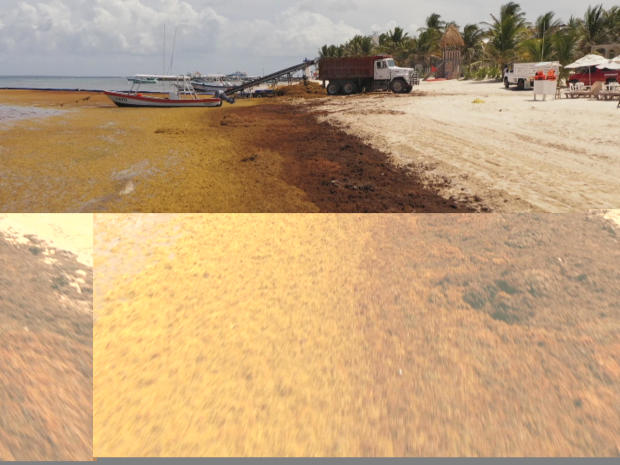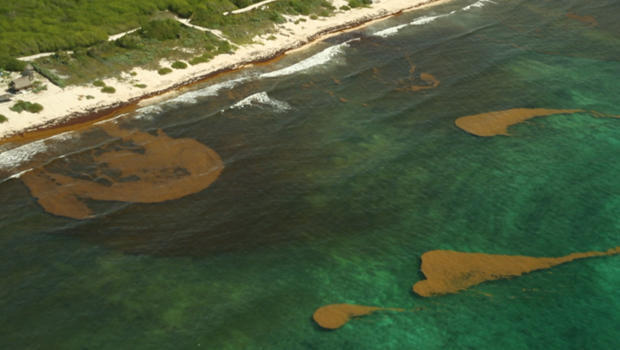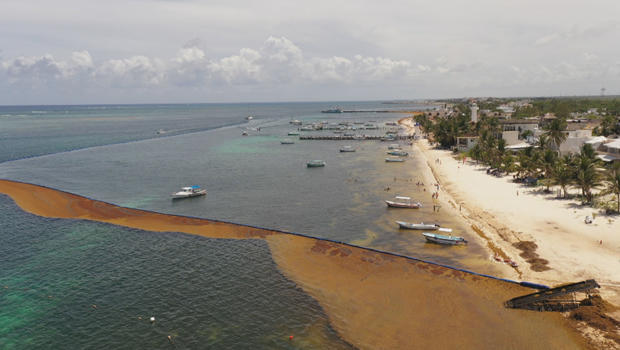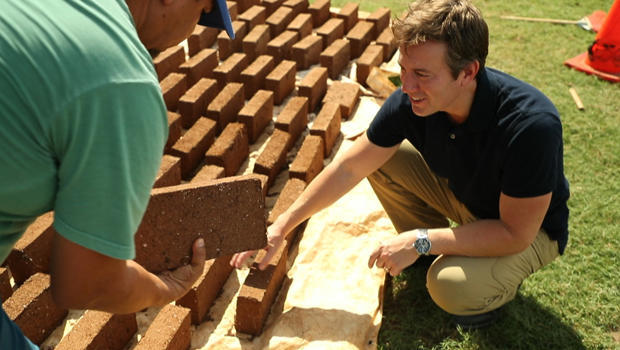Massive waves of toxic seaweed inundate Yucatan shorelines
It is the biggest algae bloom in the world: Massive waves of seaweed called sargassum washing up on shore day after day.
Jose Escalante, who has owned a small hotel in Tulum, Mexico, for eight years, said seaweed, which had been cleaned from the beach that day, will again cover the shoreline in a couple of hours.
Every day workers here in Tulum, and up and down the Yucatan Peninsula, remove tons and tons of decomposing sargassum from beaches. And every night it comes back.
Rosa Rodríguez-Martínez, from Mexico's National University, is trying to figure out why. She said sargassum used to wash ashore for two or three weeks during the summer. Now? "We are getting sargassum almost from March to October," she told "CBS This Morning" co-host Jeff Glor. "So basically, more than half of the year we are receiving massive amounts."
"That's a huge difference," said Glor.
"It's impressive," she said. "It's a problem. Economical problem, ecological, and probably a human health problem also."
Since 2011 the amount of sargassum in the Atlantic has increased dramatically. It currently forms a 5,000-mile mass from Africa to the Caribbean. It is estimated to weigh 22 million tons.
Why is it so bad right now? "I think it's because we have polluted the sea too much," said Rodríguez-Martínez. "So, now we have a lot of nutrients [in the ocean], and the algae are taking advantage of it."
Fertilizer run-off from Brazil, increased by deforestation, is believed to be the largest fuel source for the sargassum. That, combined with warming ocean water and changing ocean currents, has put the Yucatan squarely in the crosshairs.
It has gotten so bad the Mexican navy has just been put in charge of dealing with it.
They took Glor up in a reconnaissance mission to locate the largest sargassum waves.
"We are fully aware that we are only addressing the effects of sargassum," said Rear Admiral Enrique Flores Morado, who said the navy will build new sargassum-busting ships to reel in as much as they can. "But that does not solve any problem. In reality the causes have to be addressed. But given the lack of research, we are now implementing immediate actions."
Right now, many towns, and resort owners, are using floating barriers to corral and collect sargassum, including in Puerto Morelos, half an hour south of Cancun.
"We can say for sure that we are the first destination in the whole Mexican Caribbean with already a control about the sargassum," said Héctor Tamayo, director of tourism for Puerto Morelos.
"There's a lot of it, though. It doesn't look controlled," said Glor.
Tamayo said there are more than 50 trucks every day carting out sargassum.
And some are developing novel ways to use sargassum, including Omar Vasquez, who is building homes with it. Vasquez mixes with sargassum with clay and compost, which is then compressed into bricks.
"They're better than the other bricks," he said. "It does not have even a gram of cement. Everything is organic.
"I mean, it's ironic because I grew up without a house, without a home. We crossed the border to the States when I was eight years old. I came back to live my Mexican dream!"
Even though Vasquez says his homes are 100-percent organic, there may be an issue with what accumulates in the sargassum at sea.
Rosa Rodríguez-Martínez's latest research shows sargassum is high in heavy metals, like lead and arsenic. And disposal is a major issue.
Sargassum is either being dumped inland, or buried under the beach, which is illegal.
One dump site where the sargassum is taken is in the jungle, miles away from the ocean. It's unclear if the sargassum left there seeps into the ground, goes up into the air, or will just sit there forever.
It is a crisis stretching across the Caribbean, with no end in sight.
Glor asked Escalante, "For folks watching this who may not be familiar with this problem or what's happening here, what do you say?"
"It's something that is happening to the world, not just to the region," he replied. "This is just a consequence of the entire planet being in trouble."
See also:







